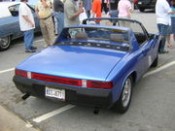Targa Top
Targa top, targa for short, is a semi-convertible car body style with a removable roof section and a full width roll bar behind the seats. The rear window can be fixed or removable, making it a convertible. In common usage, any piece of metal or trim which rises up from the side of a car and continues in an uninterrupted line over the roof and down the other side may be called a targa band, or sometimes a wrapover band. Targa tops are different from T-tops, which have a solid non-removable bar running between the passenger and driver sides of the car. These are called T-tops due to the design looking roughly like the letter T.
The word targa first came into use from the 1966 Porsche 911 Targa, though the first production car with this system as an option was actually released five years before, namely the 1961 Triumph TR4. The name was first adopted by Porsche after the Targa Florio road race. This type of body style allowed a quicker entry and exit into the car by drivers and in 1962, many race cars adopted it. Ford, and its bitter rival at the time, Ferrari, were especially fond of the Targa top in the ’60s and early 70’s for twistier road courses.
This body style became popular in the 1970s when the DOT in the United States attempted to ban convertibles, due to safety concerns when the car is overturned, such as in a rollover. As a result, manufacturers adopted Targa tops or T-bars. As Porsche helped to popularise this body style, they took out a copyright for the Targa name and manufacturers sought to look for alternative names for their removable roofs.
1996 saw the debut of a retractable glass roof, a design continued on the 996 Targa. The glass roof would retract underneath the rear window revealing a large opening. A shade was installed to help prevent the greenhouse effect from the closed roof. This system was a complete redesign since previous Targa models had a removable roof section and a wide B-pillar functioning as a roll bar. The new glass roof design allowed the 993 Targa to retain the same side-on profile as the other 911 Carrera variants and finished with the inconvenience of storing the removed top of the old system. The Targa has the body of the Cabriolet with the Targa glass roof replacing the fabric roof.
The introduction of the Mazda Miata in 1989 spurred a revival of convertibles since recent models have a roll bar incorporated into the front windscreen. Targas and T-tops have experienced a slow decline as manufacturers discountinued them one by one, putting convertibles into favor, but manufacturers will continue to produce them when it is not possible to incorporate convertible styles.
Examples of the Targa car and T-bar top body style include:
- Chevrolet Camaro (1978 – 2002)
- Chevrolet Corvette coupe (1968 – current) 2006 ZO6 Excluded
- Datsun 280ZX
- Dodge Viper (1992-2002)
- Ferrari 250P / 250LM / 330P / 330P2 / 330P3 / 330P4 / 412P / 312P
- Ferrari 512S/512M
- Ferrari Dino
- Ferrari 308 GTB
- Ferrari F355
- Fiat X1/9
- Ford GTX-1 (1966 12 Hours of Sebring winner)
- Ford GTX-1 Roadster (2005)
- Honda del sol
- Honda NSX – T
- Lotus Elise
- Matra 530
- Nissan 100NX
- Nissan 300ZX
- Porsche 904
- Porsche 906
- Porsche 911 Targa (1966-1992)
- Porsche 914
- Pontiac Firebird (1978 – 2002)
- Saab Catherina prototype
- Suzuki Cappucino (optional solid roof which can be converted into a Targa top)
- Toyota MR2 (AW11 and SW20 models)
- Toyota Supra (MKIII, MKIV)
- Triumph TR4
- Triumph TR7
- Suzuki X90




